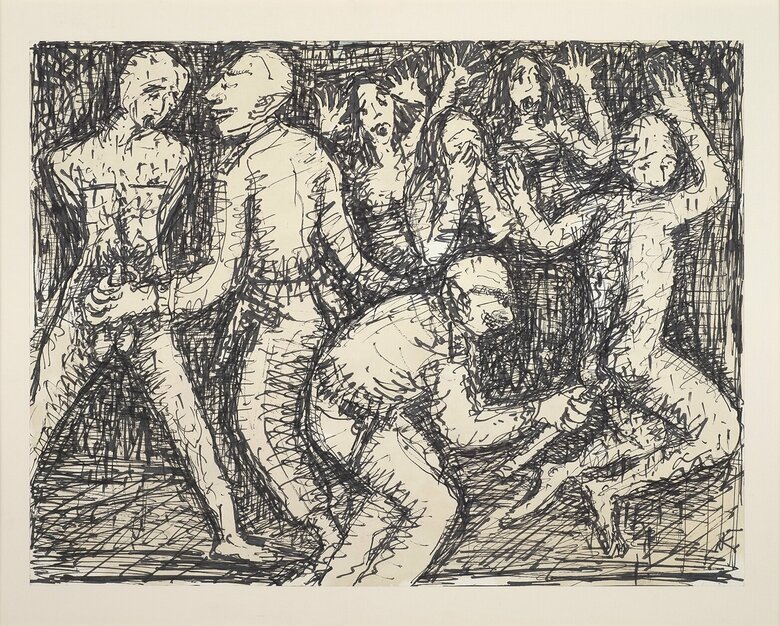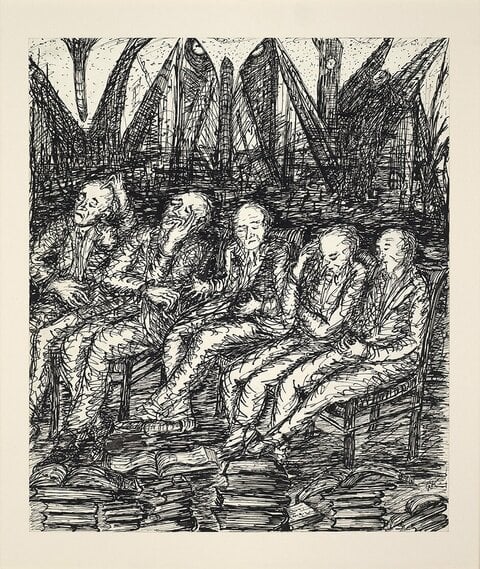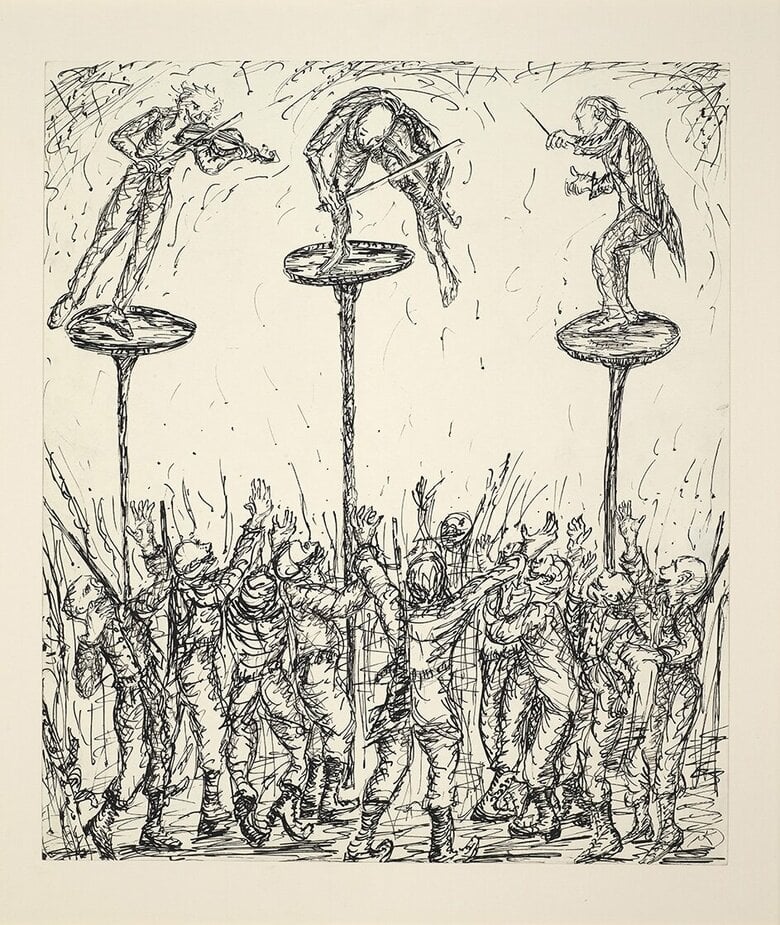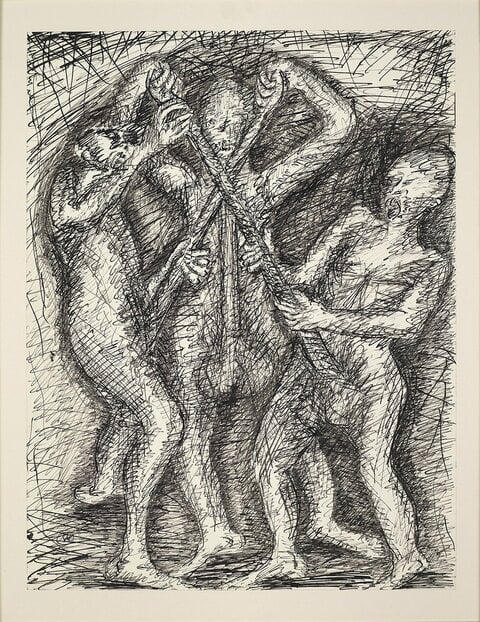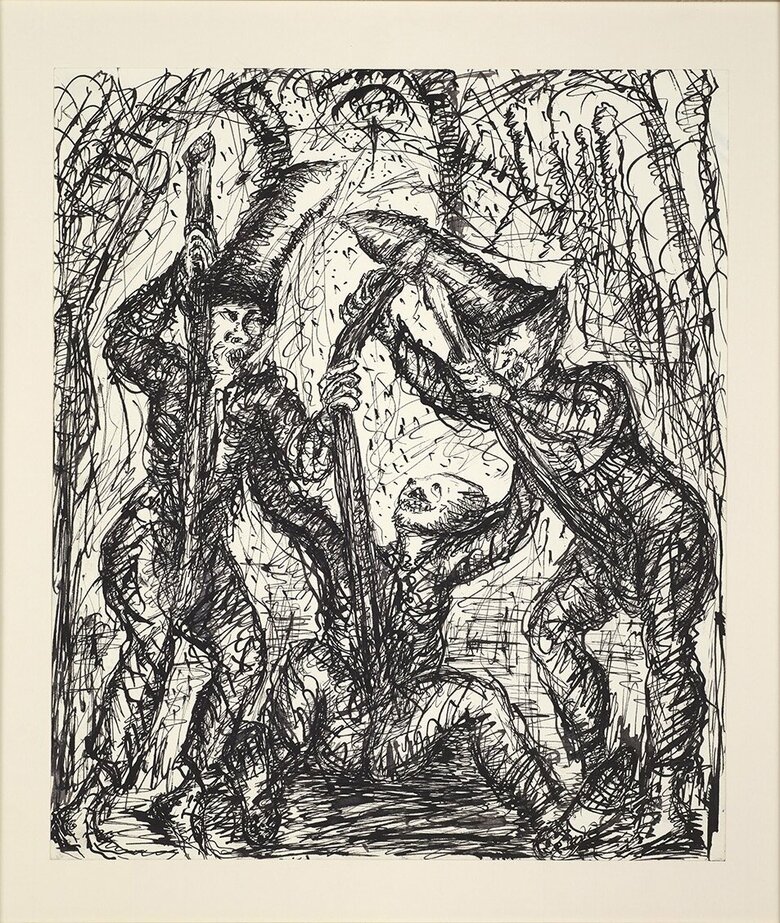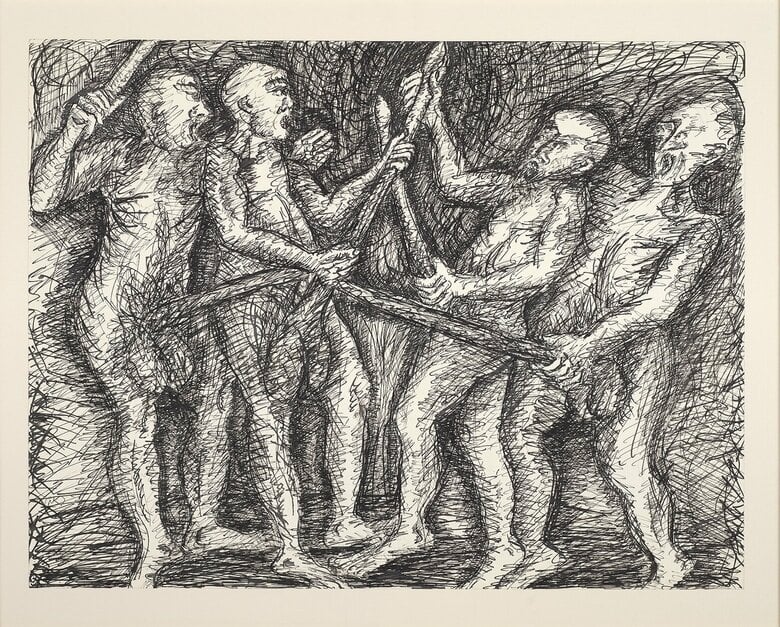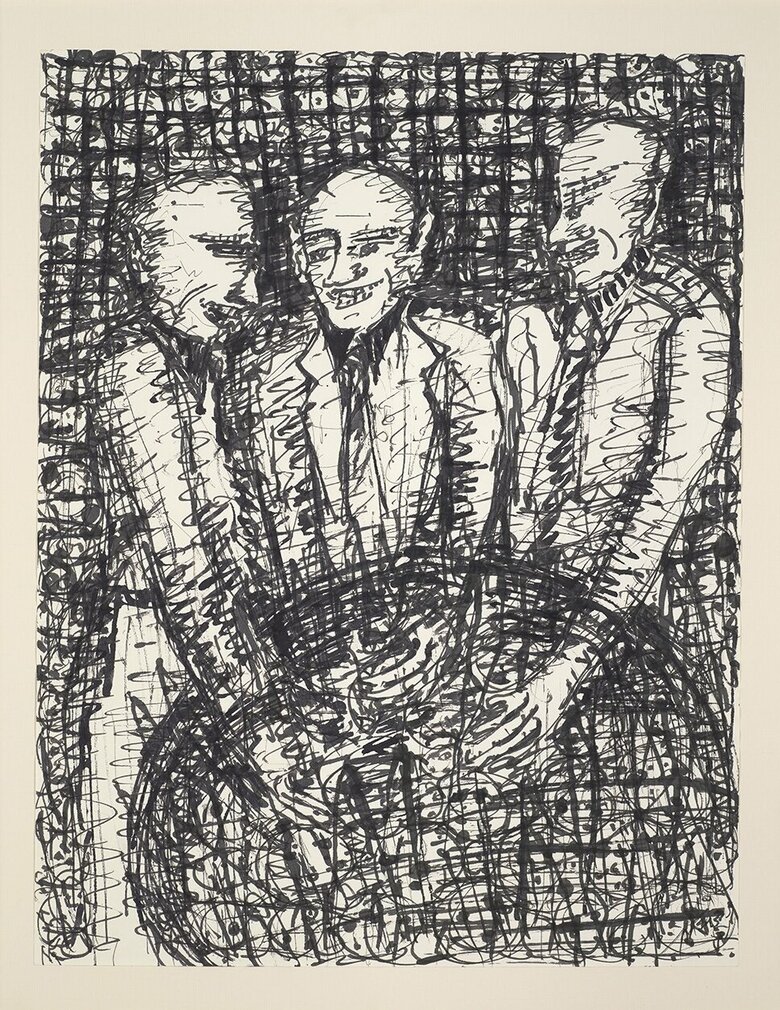Nabil Kanso, born in Beirut, Lebanon, in 1940, was a pivotal figure in neo-expressionist art. His career, spanning over five decades, was marked by a profound engagement with themes of war,...
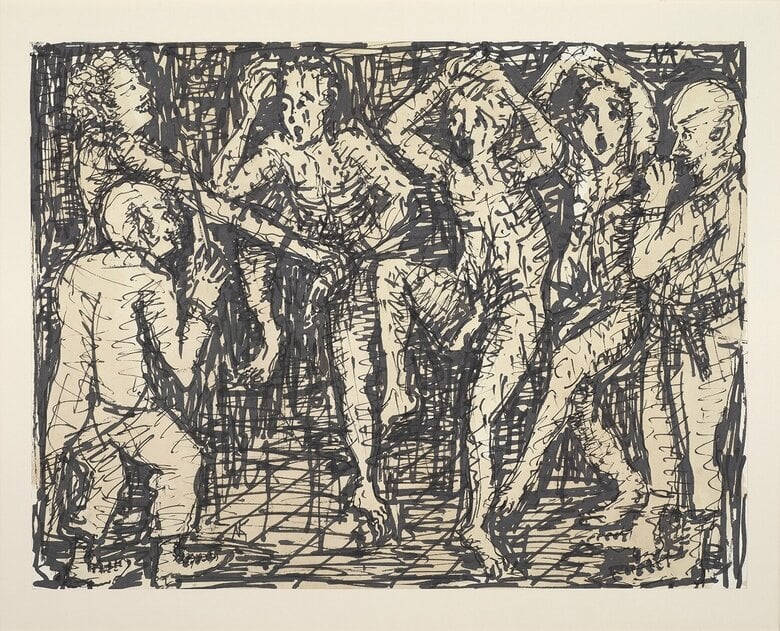


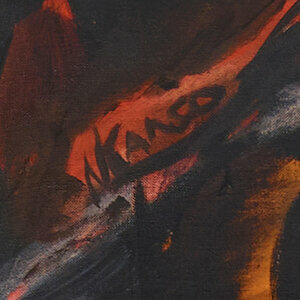

Nabil Kanso, born in Beirut, Lebanon, in 1940, was a pivotal figure in neo-expressionist art. His career, spanning over five decades, was marked by a profound engagement with themes of war,...
Nabil Kanso, born in Beirut, Lebanon, in 1940, was a pivotal figure in neo-expressionist art. His career, spanning over five decades, was marked by a profound engagement with themes of war, conflict, and the human condition. Kanso's works are recognized for their emotional intensity, dramatic use of color, and large-scale canvases, which vividly portray the impact of global and personal turmoil.
Raised in West Beirut, Kanso was deeply influenced by his early experiences in a region marked by the political instability of the Lebanese Civil War, the underlying roots of which began in 1958. That year marked the beginning of political tension between several religious factions in Lebanon: the Christians who supported the United States (namely the Eisenhower Doctrine), and the Sunnites and Druze, who supported Abdul Naser’s United Arab Republic (UAR). Kanso recalls an impactful memory that marked his transition into art; he was once stopped and reprimanded by a soldier for holding a camera. The soldier explained that a camera could be a more dangerous weapon than a gun. This experience encouraged him to start drawing. During this period, Kanso’s school was shut down, prompting him to explore his artistic interests and plan his move out of Lebanon. In 1961, he moved to London to attend the Polytechnic, studying Mathematics and Science, while also taking art classes[i]. This period was crucial in exposing him to formal art institutions and the Western art canon[ii].
In 1966, Kanso relocated to New York[iii] and enrolled at New York University (NYU), where he studied Political Science and Art History, graduating with a Bachelor’s degree in 1970 and a Master’s in 1971. His first major studio[iv] was established in New York in 1968, and by 1971, he held his first solo exhibition[v] at his 76th Street Gallery[vi], displaying 80 paintings that garnered significant attention from the art community, including Alfred Barr[vii], the first director of the Museum of Modern Art. In 1972, Kanso, along with NYU Professor Gisbert Flanz[viii], published the first English translation of the Lebanese Constitution for Constitutions of the Countries of the World.
Throughout his career, Kanso explored themes of war, human suffering, mythology, and existential angst, often reflecting his personal experiences and political views. The outbreak of the Lebanese Civil War in 1975 had a profound impact on him, influencing his style and deepening his commitment to depicting the horrors of war on canvas[ix]. He made several trips to Lebanon, like his visit in Summer of 1982, where he witnessed the destruction firsthand and continued to work on themes related to the Civil War until it ended in 1990. Kanso’s artistic approach involved painting directly onto canvases without preparatory sketches, allowing for a raw and immediate expression of his subjects. He drew inspiration from artists like Pablo Picasso and Francisco Goya, both artists were known for their powerful depictions of human suffering and conflict through emotional, dramatic, and symbolic compositions[x], such as Goya’s Third of May, 1808 and Picasso’s Guernica, 1937. Kanso’s works were also known for their expressive, gestural qualities; his palette often included fiery reds, oranges, yellows, and dark browns, creating a sense of urgency and intensity in his works[xi].
Amidst Lebanon’s period of turmoil (1970s-1990s), Kanso's artistic exploration expanded beyond the immediate devastation. From 1977 to 1979, he began his Faust series[xii], inspired by Johann Wolfgang von Goethe’s dramatic poem, which delved into the complexities of human existence and moral dilemmas, bridging the gap between the brutal realities of war and the timeless struggles depicted in classic literature[xiii]. One such vivid and dynamic composition that is part of this literary-inspired series is Twilight 2, 1979. Measuring 102 x 76 cm, this oil on canvas is currently housed at the Ramzi and Saeda Dalloul Art Foundation (DAF) in Beirut. The artwork presents a dominant naked figure in the center of the canvas, rendered in rich, warm tones of orange and red, seemingly suspended or entangled among dark, twisting branches, creating a sense of tension and entrapment. The painting’s background is a mix of purples and blues, adding depth and a sense of twilight to the scene. Kanso applies bold, expressive brushstrokes and dramatic color contrasts between light and shadow contributing to the overall intensity and emotional impact of the painting. The central human-like demonic figure is positioned exaggeratedly upside-down, with their buttocks elevated, and head positioned near the ground at the lower register. The demon’s backside and the palms of its hands reflects vulnerability of the character and their possible helplessness. This almost agonized pose, is reminiscent of Goethe’s main character Faust[xiv]. In the tragic poem, the character struggles with internal conflicts and moral contortions as he navigates his pact with the devil and the consequences of his actions, expressively portrayed in Kanso’s depiction.
Another series Kanso worked on from 1974 well into 1994 is The Split of Life series[xv], consisting of around 80 mural-size paintings. One artwork from the series is Lebanon 1977: Vortices of Wrath, 1977, which is part of the DAF collection. Vortices of Wrath is a monumental painting measuring 310 x 716 cm; it is divided into three panels, forming a triptych. Characterized by its chaotic and tumultuous composition, the tryptic depicts a violent and emotional scene. We see figures within the artwork twisted and contorted, seemingly caught in a vortex of destruction and anguish. Its dominant colors schemes of fiery reds, oranges, and dark tones, tend to intensify the sense of conflict and devastation. Typical of Kanso’s expressive style, the frantic brushstrokes contribute to the dynamic and turbulent atmosphere, capturing the brutality and suffering of the Lebanese Civil War.
Nabil Kanso’s contributions to art extend beyond his powerful visual narratives. His works serve as a compelling commentary on the human condition, encouraging viewers to confront uncomfortable truths and engage with the deeper aspects of existence. Kanso was not only impacted by the war in Lebanon, but also the Vietnam War (1955-1975) and the Gulf War (1991). He produced works that reflected the struggle and pain of global conflicts. Kanso continued to create impactful art until his death in 2019, addressing critical issues such as mass incarceration, racial and ethnic discrimination, and global conflicts[xvi].
In 1975, Kanso moved to the South of the United States, and worked in various studios in North and South Carolina, and later in Louisiana. These regions, known for their rich cultural heritage and musical history, provided a unique backdrop for Kanso's exploration of jazz music through his art. There he was inspired to create his Jazz series, 1978-1979[xvii]. In 1980, Kanso settled in Atlanta, got married, and continued to hold exhibitions in South America, Switzerland, Korea, and the Middle East. He passed away in 2019 at the age of 79, after a battle with cancer.[xviii]
Nabil Kanso’s art remains a significant and influential force in contemporary art, bridging the personal and the universal through his poignant and powerful visual expressions. His son, Daniel Kanso, asserts that his father’s paintings were never sold to auction houses or galleries because his father wanted them to convey a much more important message of “peace, pacifism and humanism” [xix]. His legacy endures through his extensive body of work, which continues to inspire and provoke thought on the human experience and the pervasive impact of violence and conflict.
Edited by Wafa Roz
Notes:
[i] “Chronology.” NabilKanso.Org, www.nabilkanso.org/chronology. Accessed 15 Aug. 2023.
[ii] “Life and Art.” NabilKanso.Org, www.nabilkanso.org/ life-and-art. Accessed 22 May, 2024.
[iii] Maria Lacey. (1985, April 26). Violent scenes erupt from artist’s experiences. The Daily Journal, p. 23.
[iv] Maria Lacey. (1985, April 26). Violent scenes erupt from artist’s experiences. The Daily Journal, p. 23.
[v] Catherine Fox. (1984, July 8). Artist inspired by war-torn homeland. Atlanta Journal-Constitution, p. 153.
[vi] “Life and Art.” NabilKanso.Org, www.nabilkanso.org/ life-and-art. Accessed 22 May, 2024.
[vii] “Life and Art.” NabilKanso.Org, www.nabilkanso.org/ life-and-art. Accessed 22 May, 2024.
[viii] “Chronology.” NabilKanso.Org, www.nabilkanso.org/chronology. Accessed 22 May, 2024.
[ix] Lubna Rages, Interview with Daniel Kanso, The Ramzi and Saeda Dalloul Art Foundation. Sep. 8, 2023.
[x] “Nabil Kanso: A Journey of Art, War and Peace.” Art Breath, 14 Dec. 2019.
[xi] Catherine Fox. (1985, September 19). Artists turn up the heat with ‘Fantastic Visions’ at Nexus Gallery. Atlanta Journal-Constitution, p. 42.
[xii] “Life and Art.” NabilKanso.Org, www.nabilkanso.org/ life-and-art. Accessed 22 May, 2024.
[xiii] “Nabil Kanso: Faust Paintings”, NEV Editions, 1996. p.10
[xiv] “Nabil Kanso: Faust Paintings”, NEV Editions, 1996. p.10
[xv] “Chronology.” NabilKanso.Org, www.nabilkanso.org/chronology. Accessed 22 May, 2024.
[xvi] “Life and Art.” NabilKanso.Org, www.nabilkanso.org/ life-and-art. Accessed 22 May, 2024.
[xvii] “Life and Art.” NabilKanso.Org, www.nabilkanso.org/life-and-art. Accessed 12 Aug. 2023.
[xviii] “Chronology.” NabilKanso.Org, www.nabilkanso.org/chronology. Accessed 15 Aug. 2023.
[xix] Talass, Rawaa. “Lebanese-American master Nabil Kanso’s son discusses his late father’s work and legacy”. Arab News. Apr. 30, 2023. www.arabnews.com/node/
Sources
“Chronology.” NabilKanso.Org, www.nabilkanso.org/chronology. Accessed 15 Aug. 2023.
“Chronology.” NabilKanso.Org, www.nabilkanso.org/chronology. Accessed 22 May. 2024.
“Life and Art.” NabilKanso.Org, www.nabilkanso.org/life-and-art. Accessed 12 Aug. 2023.
“Life and Art.” NabilKanso.Org, www.nabilkanso.org/life-and-art. Accessed 22 May. 2024.
“Nabil Kanso: A Journey of Art, War and Peace.” Art Breath, 14 Dec. 2019.
“Nabil Kanso: Faust Paintings”, NEV Editions, 1996.
Fox, Catherine. “Artist inspired by war-torn homeland”. Atlanta Journal-Constitution, July 8, 1984, p. 153.
Fox, Catherine. “Opinions give ‘The Political Show’ potence”. Atlanta Journal-Constitution, June 24, 1984, p. 189.
Fox, Catherine. “Artists turn up the heat with ‘Fantastic Visions’ at Nexus Gallery”. Atlanta Journal-Constitution, Sep. 19, 1985, p. 42.
Stephenson, Kathy, “The Art World of Nabil Kanso”. Our World, Sep.1984, pp. 36-37.
Rages, Lubna, Interview with Daniel Kanso, The Ramzi and Saeda Dalloul Art Foundation. Sep. 8, 2023.
Lacey, Maria. Violent scenes erupt from artist’s experiences. The Daily Journal, April 26, 1985, p. 23.
Talass, Rawaa. “Lebanese-American master Nabil Kanso’s son discusses his late father’s work and legacy”. Arab News. Apr. 30, 2023. https://www.arabnews.com/node/2294256/ lifestyle.
سيد هويدي, "نبيل قانصو يعلن الحرب على الحرب", الوطن, 23 ابريل 1992, الكويت.
Selected Solo Exhibitions
Nabil Kanso: Echoes of War, Eli and Edith Broad Museum, Michigan, USA
Nabil Kanso: The Tomorrows, Martos Gallery, New York City, United States
Nabil Kanso: Endless Night, IAIA, Institute of Arab and Islamic Art, Greenwich Village, New York, USA
Nabil Kanso: Journey of Art for Peace, High Museum of Art, Atlanta, Georgia, USA
Art, War and the Split of Life, The Permanent Mission of the Bolivarian Republic of Venezuela to the United Nations, New York City, United States of America
Compromis pour la paix: Peintures de Nabil Kanso, Musée international de la Croix-Rouge et du Croissant-Rouge, Geneva, Switzerland
Desert Storm: Invasion of Kuwait, Free Atelier Art Center, Kuwait City, Kuwait
Nabil Kanso: Exposicion de Pintura (Nabil Kanso: Exhibition of Paintings), Museo Universitario Del Chopo, Mexico City, Mexico
Nabil Kanso: Apocalypse, Museu De Arte Do Rio Grande Do Sul (MARGS),Porto Alegre, Brazil
Arte Para La Paz: Nabil Kanso (Art for Peace: Nabil Kanso), Instituto Nacional De Cultura, Galeria De Aete INAC, Panamá, Panamá
Arte por la Paz: II Symposium Iberoamericano Sobre Municipio y Medio Ambiente (Art for Peace: Nabil Kanso),Museo Caracas, Caracas, Venezuela
Nabil Kanso: Arte Para La Paz (Nabil Kanso: Art for Peace), Museo Caracas, Caracas, Venezuela
Pinturas De Nabil Kanso (Retrospective of Paintings by Nabil Kanso), Ateneo De Caracas, Galeria Los Espacios Calidos, Caracas, Venezuela
Nabil Kanso’s Othello, Nexus Center of Contemporary Art – Atlanta Theatrical Outfit, Atlanta, Georgia, United States of America
The Split of Life, Nexus Center of Contemporary Art, Atlanta, Georgia, United States of America
N. Kanso Drawings, Seventy Sixth Street Gallery, New York City, New York, United States of America
An exhibition of paintings, pastels, and watercolors (1968-71) by Nabil Kanso, Seventy Sixth Street Gallery, New York City, New York, United States of America
Realism and Beyond Realism: An exhibition of recent paintings and drawings by Kanso, Seventy Sixth Street Gallery, New York City, New York, United States of America
Selected Group Exhibitions
A Banquet for Seaweed: Snapshots from the Arab 1980s, University of North Texas, College of Visual Arts & Design, Guest Curated by Nada Shabout, University of North Texas, Denton, Texas
Memory Sews Together Events That Hadn't Previously Met, Sharjah Art Museum, Featuring Works from the Barjeel Art Foundation, Sharjah Art Museum, Sharjah, United Arab Emirates
Picasso et les avant-gardes Arabes, Joint exhibition of the the Institut du Monde Arabe, Tourcoing, and Musée Picasso, Paris, Institut du Monde Arabe, Tourcoing, France
Artistas del Segundo Centenario, Joint exhibition of the Consul Generals of Argentina, Chile, Colombia, Mexico and Venezuela, Consulate General of Argentina, New York City, New York, United States of America
Works of Peace: 111 Artists, Galerie Bhak, Seoul, South Korea
The Art of Atlanta, Southeastern Center for Contemporary Art, Winston-Salem, North Carolina, United States of America
Inside out: 20 artists from Atlanta, U.S.A., Malmö Konsthall, Malmö, Sweden
Fantastic Visions, Nexus Center of Contemporary Art, Atlanta, Georgia, United States of America
Publications
Kanso, Nabil. The split of life: Nabil Kanso: Paintings 1974-1994. NEV Editions
Kanso, Nabil. Othello: Paintings. NEV Editions
Kanso, Nabil. Faust: Paintings. Nev Editions
Awards and honors
Adolph and Esther Gottlieb Foundation's prestigious Individual Support Grant, New York City, United States of America
Collections
Ramzi and Saeda Dalloul Art Foundation, Beirut, Lebanon
The Nabil Kanso Estate, Atlanta, Georgia, United States
Barjeel Art Foundation, Sharjah, United Arab Emirates
The Nicolas Ibrahim Sursock Museum, Beirut, Lebanon
The High Museum of Art, Atlanta, United States
The Solomon R. Guggenheim Museum, New York, United States
Join us in our endless discovery of modern and contemporary Arab art
Get updates from DAF
Follow Artists
Save your favourite Artworks
Share your perspectives on Artworks
Be part of our community
It's Free!
We value your privacy
TermsCookiesPrivacy Policies
Get updates from DAF
Follow Artists
Save your favourite Artworks
Share your perspectives on Artworks
Be part of our community
It's Free!
We value your privacy
TermsCookiesPrivacy Policies
Get updates from DAF
Follow Artists
Save your favourite Artworks
Share your perspectives on Artworks
Be part of our community
It's Free!
We value your privacy
TermsCookiesPrivacy Policies
If you have entered your email to become a member of the Dalloul Art Foundation, please click the button below to confirm your email and agree to our Terms, Cookie & Privacy policies.
We value your privacy, see how
Get updates from DAF
Follow Artists
Save your favourite Artworks
Share your perspectives on Artworks
Be part of our community
It's Free!
We value your privacy
TermsCookiesPrivacy Policies
